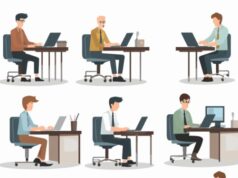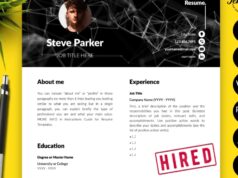In today’s digital first world, effective writing techniques have become an essential ability for almost everyone from a particular office skills. Whether you are a professional data registration, material manufacturer, programmer or students, affect your ability to write quickly and accurately productivity and career outlook.
Why Typing Speed and Accuracy Matter
Research suggests that the average writing speed is about 40 words per minute (WPM), while professional typists often occur with close accuracy more than 70-90 WPM. This difference not only represents the saved time, but also significantly improves the efficiency of workflow and significantly reduces physical stress.
This wide guide will run through proven techniques to improve both the writing speed and accuracy, whether you want to create an early habits or the purpose of an experienced machinewriter to break through the performance plateau.
The Foundations of Efficient Copy Typing
Perfect Posture and Ergonomics
Before focusing on keyboard techniques, establishing proper posture creates the foundation for both speed and long-term typing health:
- Spine alignment: Sit with your back straight, shoulders relaxed, and feet flat on the floor
- Eye level: Position your screen at eye level, about an arm’s length away
- Wrist position: Keep wrists straight and hovering slightly above the keyboard, not resting on the desk
- Elbow angle: Maintain approximately 90-degree angles at your elbows
- Regular breaks: Follow the 20-20-20 rule—every 20 minutes, look at something 20 feet away for 20 seconds
Proper ergonomics prevents repetitive strain injuries while simultaneously enabling faster, more comfortable typing sessions.
Mastering Touch Typing Fundamentals
Touch typing—typing without looking at the keyboard—is non-negotiable for achieving professional-level speed and accuracy:
- Home row positioning: Always start with fingers on ASDF (left hand) and JKL; (right hand)
- Finger responsibility: Each finger is responsible for specific keys:
- Left pinky: Q, A, Z and modifiers
- Left ring: W, S, X
- Left middle: E, D, C
- Left index: R, F, V, T, G, B
- Right index: Y, H, N, U, J, M
- Right middle: I, K, ,
- Right ring: O, L, .
- Right pinky: P, ;, / and modifiers
- Thumbs: Dedicated to the spacebar
This finger mapping creates muscle memory that dramatically increases copy typing efficiency over time. According to typing research, proper touch typing technique alone can increase speeds by 30-50% compared to “hunt and peck” methods.
Advanced Techniques to Accelerate Typing Speed
Rhythm and Timing Strategies
Professional typists often describe developing an internal rhythm that paces their typing:
- Consistent keystroke timing: Focus on striking keys with consistent force and rhythm
- Word-level thinking: Train yourself to think in terms of complete words rather than individual letters
- Flow state development: Regular practice helps develop a “flow state” where typing becomes nearly automatic
Specialized Drills for Speed Development
Targeted practice produces faster results than general typing:
- N-gram drills: Practice common letter combinations (th, er, on, etc.) until they become automatic
- High-frequency word sprints: Practice typing the 100 most common words in English until they flow effortlessly
- Progressive speed challenges: Use timed exercises that gradually push your comfort zone by 5-10 WPM
Accuracy-Focused Training Techniques
Speed without accuracy creates inefficiency due to correction time. These techniques specifically target error reduction:
- Deliberate slowdown practice: Periodically practice at 70% of your maximum speed with a focus on zero errors
- Error pattern identification: Track which specific key combinations or words consistently cause errors
- Targeted weakness drills: Create custom exercises focusing exclusively on your challenging combinations
Optimizing Your Typing Environment
Keyboard Selection and Customization
Your typing hardware significantly impacts performance:
- Mechanical vs. membrane: Mechanical keyboards with tactile feedback generally enable faster, more accurate typing
- Key switch types: Different switch types (Cherry MX Blue, Brown, Red, etc.) offer varying levels of tactile feedback and noise
- Keyboard layout options: Consider ergonomic layouts or specialized formats for specific use cases
- Key travel distance: Find your optimal key travel distance (typically 2-4mm) that balances speed and accuracy
Software Tools for Typing Enhancement
Modern software can accelerate your typing skill development:
- Typing tutors: Applications like TypingClub, Keybr, and Typing.com offer structured learning paths
- Text expansion tools: Software like TextExpander or PhraseExpress automates frequently typed phrases
- Typing analytics: Programs that analyze your typing patterns and identify specific improvement opportunities
- Gamified practice: Typing games that make regular practice more engaging and sustainable
According to a study published in the Journal of Applied Psychology, users who track their typing metrics improve 23% faster than those who practice without measurement.
Professional Copy Typing Techniques
Industry-Specific Optimization
Different fields require specialized typing approaches:
- Transcription specialists: Develop foot pedal coordination and specialized shorthand systems
- Programmers: Learn language-specific keyboard shortcuts and coding-optimized layouts
- Data entry professionals: Master number pad techniques and data validation shortcuts
- Content writers: Implement research-while-typing workflows and outlining strategies
Managing Complex Copy Tasks
Professional typists use systematic approaches for challenging materials:
- Chunking complex content: Break difficult text into manageable segments
- Pre-reading technique: Quickly scan upcoming text while typing current content
- Format preservation strategies: Develop efficient methods for maintaining source formatting
- Error recovery systems: Create personal protocols for quickly identifying and correcting mistakes
Overcoming Common Typing Plateaus
Breaking the Speed Barrier
Many typists hit performance plateaus at predictable intervals (usually around 40, 60, and 80 WPM):
- Counterintuitive technique: Sometimes slowing down deliberately and rebuilding with perfect form breaks plateaus
- Varied practice materials: Introduce unfamiliar vocabulary and formats to challenge comfort zones
- Speed bursts: Integrate short, maximum-speed typing intervals into regular practice
- Finger independence exercises: Practice drills that specifically target weaker fingers or combinations
Physical Conditioning for Typing Endurance
Physical factors often limit typing performance:
- Finger strengthening exercises: Simple exercises to build finger dexterity and strength
- Wrist and forearm stretches: Routines to prevent fatigue during extended typing sessions
- Hand temperature management: Techniques to maintain optimal hand temperature for typing performance
- Micro-break protocols: Structured tiny breaks that prevent fatigue without disrupting workflow
Measuring and Tracking Typing Improvement
Effective Metrics Beyond WPM
While words per minute is the standard measurement, other metrics provide valuable insight:
- Accuracy percentage: Track error rates alongside speed
- Consistency score: Measure the variation in your typing speed
- Fatigue resistance: Track performance over longer durations
- Recovery speed: Measure how quickly you correct errors when they occur
Creating a Sustainable Improvement Plan
Lasting improvement requires structured practice:
- Daily micro-practice: Even 10-15 minutes of focused practice creates significant improvement
- Progressive challenge system: Gradually introduce more difficult material as skills improve
- Measurement frequency: Find the optimal tracking interval that motivates without obsession
- Plateau response protocols: Predetermined strategies for when progress stalls
The Typing Mastery Journey
Developing extraordinary writing skills is less about innate talent and is more consistent with the right technology, intentionally more about practice. Most can double their writing speeds by implementing the basis of good ergonomics, mastering touching basic and practicing regular targeted exercises.
Remember that writing mastery is finally about communication efficiency – quickly and more accurately, you can move your ideas to the text, more efficiently you can communicate in our fast digital world.










